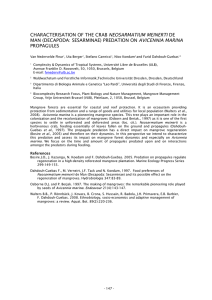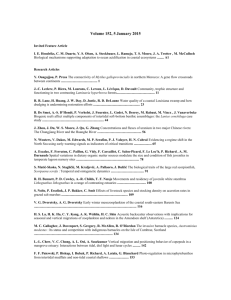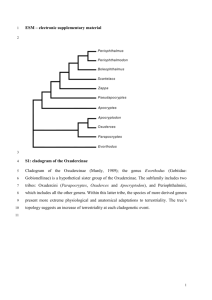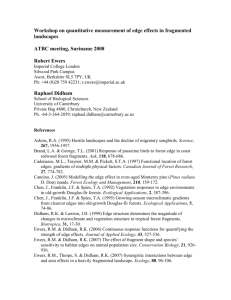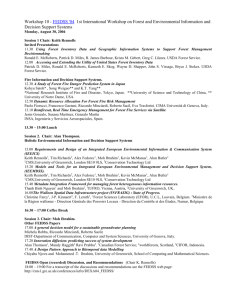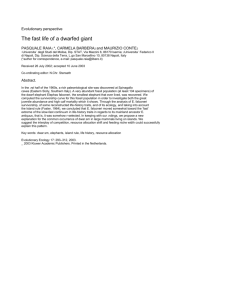Spatial correlation between macro-fauna, vegetation structure and
advertisement
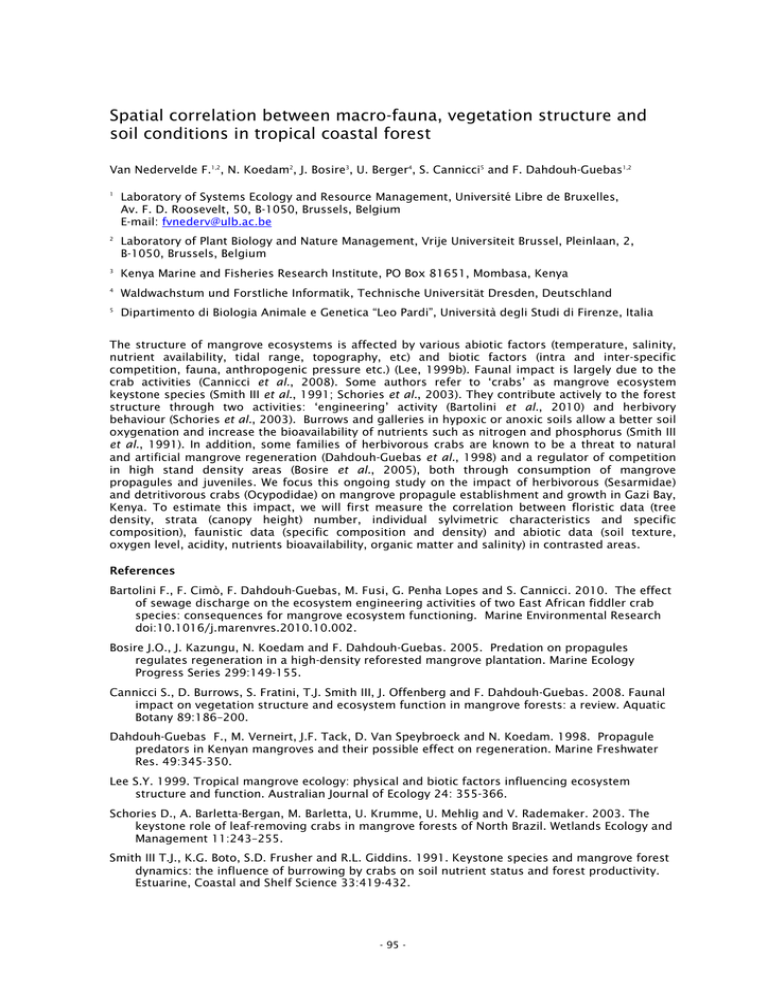
Spatial correlation between macro-fauna, vegetation structure and soil conditions in tropical coastal forest Van Nedervelde F.1,2, N. Koedam2, J. Bosire3, U. Berger4, S. Cannicci5 and F. Dahdouh-Guebas1,2 1 Laboratory of Systems Ecology and Resource Management, Université Libre de Bruxelles, Av. F. D. Roosevelt, 50, B-1050, Brussels, Belgium E-mail: fvnederv@ulb.ac.be 2 Laboratory of Plant Biology and Nature Management, Vrije Universiteit Brussel, Pleinlaan, 2, B-1050, Brussels, Belgium 3 Kenya Marine and Fisheries Research Institute, PO Box 81651, Mombasa, Kenya 4 Waldwachstum und Forstliche Informatik, Technische Universität Dresden, Deutschland 5 Dipartimento di Biologia Animale e Genetica “Leo Pardi”, Università degli Studi di Firenze, Italia The structure of mangrove ecosystems is affected by various abiotic factors (temperature, salinity, nutrient availability, tidal range, topography, etc) and biotic factors (intra and inter-specific competition, fauna, anthropogenic pressure etc.) (Lee, 1999b). Faunal impact is largely due to the crab activities (Cannicci et al., 2008). Some authors refer to ‘crabs’ as mangrove ecosystem keystone species (Smith III et al., 1991; Schories et al., 2003). They contribute actively to the forest structure through two activities: ‘engineering’ activity (Bartolini et al., 2010) and herbivory behaviour (Schories et al., 2003). Burrows and galleries in hypoxic or anoxic soils allow a better soil oxygenation and increase the bioavailability of nutrients such as nitrogen and phosphorus (Smith III et al., 1991). In addition, some families of herbivorous crabs are known to be a threat to natural and artificial mangrove regeneration (Dahdouh-Guebas et al., 1998) and a regulator of competition in high stand density areas (Bosire et al., 2005), both through consumption of mangrove propagules and juveniles. We focus this ongoing study on the impact of herbivorous (Sesarmidae) and detritivorous crabs (Ocypodidae) on mangrove propagule establishment and growth in Gazi Bay, Kenya. To estimate this impact, we will first measure the correlation between floristic data (tree density, strata (canopy height) number, individual sylvimetric characteristics and specific composition), faunistic data (specific composition and density) and abiotic data (soil texture, oxygen level, acidity, nutrients bioavailability, organic matter and salinity) in contrasted areas. References Bartolini F., F. Cimò, F. Dahdouh-Guebas, M. Fusi, G. Penha Lopes and S. Cannicci. 2010. The effect of sewage discharge on the ecosystem engineering activities of two East African fiddler crab species: consequences for mangrove ecosystem functioning. Marine Environmental Research doi:10.1016/j.marenvres.2010.10.002. Bosire J.O., J. Kazungu, N. Koedam and F. Dahdouh-Guebas. 2005. Predation on propagules regulates regeneration in a high-density reforested mangrove plantation. Marine Ecology Progress Series 299:149-155. Cannicci S., D. Burrows, S. Fratini, T.J. Smith III, J. Offenberg and F. Dahdouh-Guebas. 2008. Faunal impact on vegetation structure and ecosystem function in mangrove forests: a review. Aquatic Botany 89:186–200. Dahdouh-Guebas F., M. Verneirt, J.F. Tack, D. Van Speybroeck and N. Koedam. 1998. Propagule predators in Kenyan mangroves and their possible effect on regeneration. Marine Freshwater Res. 49:345-350. Lee S.Y. 1999. Tropical mangrove ecology: physical and biotic factors influencing ecosystem structure and function. Australian Journal of Ecology 24: 355-366. Schories D., A. Barletta-Bergan, M. Barletta, U. Krumme, U. Mehlig and V. Rademaker. 2003. The keystone role of leaf-removing crabs in mangrove forests of North Brazil. Wetlands Ecology and Management 11:243–255. Smith III T.J., K.G. Boto, S.D. Frusher and R.L. Giddins. 1991. Keystone species and mangrove forest dynamics: the influence of burrowing by crabs on soil nutrient status and forest productivity. Estuarine, Coastal and Shelf Science 33:419-432. - 95 -
